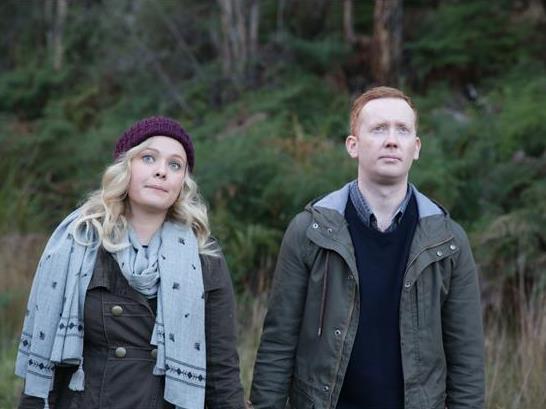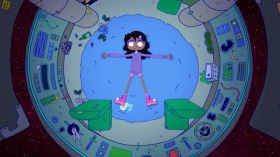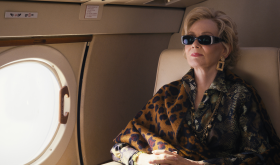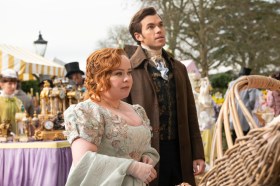‘Look, Look, it’s a rare Zeitgeist parrot…’ Image is actually Katie Robertson and Luke McGregor from Rosehaven.
In the immediate news, the Federal Government’s Midyear Economic and Fiscal Outlook Statement has nothing about the sector, so Screen Australia, the ABC and SBS have been spared. With the former Minister of the Arts and current Attorney-General on his way to the Court of St James in London, the government will have a reshuffle. I don’t think the bureaucracy expects a change in the Arts portfolio.
UPDATE: While Fifield has kept the Arts Ministry, the Australia Council has been cut by $5.4m over three years, to protect the Creative Partnerships Australia Program, which is co-funded with business and philanthropic interests.
Screen Australia has slowly redefined the Enterprise Program over the last eight years, until it has moved from what Richard Harris, the Head of Business and Audience, calls ‘skyscraper investments’ to a fine-grained program of infill.
In the latest announcements, almost $3m has been allocated to seven Enterprise Ideas programs and twelve Enterprise People placements. The funds have been split down the middle and the placements carry wages.
In the Enterprise Ideas program, Aboriginal media organisation CAAMA is funded to develop an ‘organisational direction and plan, with the primary objective of achieving ongoing sustainability,’ in the words of the announcement.
Guesswork Distribution, aka Kevin Whyte, involved with Rosehaven, Please Like Me and Get Krack!n, want to ‘establish themselves in the global market in order to develop, produce and distribute quality scripted and unscripted content for global audiences.’
Made Up Stories brings producer Bruna Papandrea together with Jodi Matterson to ‘develop a slate of six to eight optioned Australian properties sought from Australian female authors, with a focus on strong and complex female leads‘. They are starting with Babadook director Jennifer Kent’s next film, The Nightingale.
Northern Rivers not-for-profit Screenworks will have the money to build on The Athena Project and Deadlock with Every Cloud, by running ‘script development labs for three projects from various production companies that will be regional in location and employ local talent. This initiative will offer regional people the opportunity to work with larger city-based companies, whilst also providing those companies with the chance to uncover new talent and voices. State agencies Create NSW, Screen Queensland and Screen Territory have offered their support to run these three labs, with a second stage planned to broaden Screenworks’ connections with regional communities nationally.’
Start VR, based in Sydney and Los Angeles, will run a VR Artist Residency program as ‘ a 12-month pilot program that will support Start VR’s work at its Sydney studio in an effort to foster new talent in the rapidly growing VR industry. The program will invite two creative practitioners, in a residency capacity, to explore the creative and technological possibilities of immersive storytelling.’
What does this list prove? In conversation Richard Harris acknowledged that ‘none of the projects are superinnovative but they do hit key goals.’
Every one of these programs looks sensible and useful. We can image the detail of the projects and the amount of practical research. What do they say about innovation? The sector is staggeringly conservative, pushing programs which have been attempted in various ways for at least thirty years. Some look a lot like Screen Resource Organisation ideas.
Remarkably, the projects add up to a map of the various cultural initiatives that are central to Screen Australia’s thinking at the moment. Diversity, tick. Gender, tick. Regionalism, tick, industry globalisation, tick. Indigenous production, tick.
Does this mean that Screen Australia has become a social engineering agency, funding people who allow themselves to collaborate with its soft left objectives?
Harris acknowledges that the program is now operating around the margins, having supported major companies to develop structures which benefit the mainstream. Now, he says, ‘We want to see things that have benefit for the whole sector or are significantly game changing.’
Agencies are being tempted by a more activist role, because the fundamental role of government support is changing. Companies need project support, but they are also working like crazy to adapt to a frenzy of continuous change. The strategies haven’t changed but the cost and outcomes have.
Harris also argues that $1.6m, the cost of this program, is a tiny fraction of the $71m of total investments. While the agency is committed to supporting social change, almost all its work remains very conventional, away from any social engineering objectives.
Here is another twist. Three of these programs, about regional NSW and Western Sydney, are consistent with the objectives of the State government. One of them explicitly links Create NSW, Screen Territory and Screen Queensland, all of which have very different political stripes.
Am I right in thinking that the companies have shaped their program to appeal to the agency’s politics? Neither Harris nor the participants would agree with that idea because they have been working with those ideas for some time. They have simply taken an opportunity. It is more likely that the agencies, the sector guilds and individual producers have understood the common need to make changes and created a Zeitgeist.
Here’s just one indication: The Australian Guild of Screen Composers has announced it has elected its first woman President. Caitlin Yeo replaces Guy Gross who retired after five years, while Brett Aplin was elected Vice-President. According to the announcement, ‘Gender equity has been a focus of the AGSC for the past couple of years. This year women make up 40% of the Board.’ They are elected, which means they have been supported by a majority of men.
Zeitgeist is about collective curiosity – we all end up talking about the same issues at the same time. Last week, for instance, Screen Australia announced the second winner of the tripartite Create NSW, ABC Arts and Scroz funding of a single feature length arts documentary to launch at the Sydney Film Festival. The first was Kriv Stender’s film The Go-Betweens: Right Here. It was very much about a personal obsession with one sub-cultural band which climaxed in the 1980s.
This year’s film will be made by Media Stockade, a company driven by its values, which started with I am a Girl and went on to make Surgery Ship and The Opposition. They are very good at social media. They are supporting documentary photographer Olivia Martin-McGuire on her first feature doc. The announcement says,
Double Happiness will take viewers on a billion-dollar ride of fantasy, aspiration, hope and reconciliation, exploring contemporary China and its relationship with Australia from the fascinating aspect of the burgeoning pre-wedding photography industry.
Ah, China. Surely part of our current Zeitgeist.
However, that notion of Zeitgeist is a two edged sword. Produce a film that grabs a collective obsession, and you break through to substantial box office. Sherpa is a great example, as it touched our fascination with local cultures, the majesty and challenge of mountains, our hunger to travel and our disquiet about our privilege on Third World adventures. I was blown away by it.
But Zeitgeist is also about closing minds, about limiting our frames of reference. Sherpa did a great job of pushing the envelope as it brought in Nepalese politics and exploitation of the tourism industry. There’s another film to be made about governments grappling with development, starvation and education, but that would be boring. Unless of course we could find a central hero on a dramatic narrative.
The truth is, the narrowness is not just the collective world view of the screen community – it is also about how we choose to tell stories, and the point of view we deploy. And that is why we have just begun to talk about diversity.





